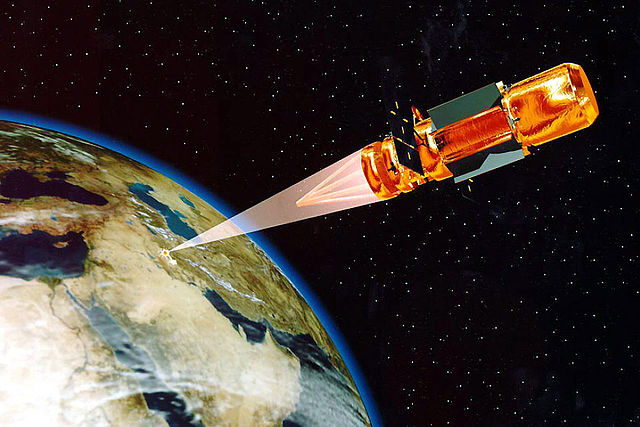 Hypothetical space-based laser concept art from U.S. Space Command’s “Vision for 2020”
Hypothetical space-based laser concept art from U.S. Space Command’s “Vision for 2020”
Space-based Weapon Perils
Space-based weapons can offer battlefield and strategic advantages, but those gains are not always worth the costs they impose on strategic stability or the risks of spawning security dilemmas—situations in which defensive developments are mistaken by an adversary as offensive in nature. Historically, the Reagan, W. Bush, and Trump administrations expressed interest in advanced space-based weapons. While the Pentagon oscillates between unveiling a classified new space weapon and delaying its reveal, the Biden Administration should evaluate if the perils posed by space weaponization best serve the national interest. Restraint in orbit certainly has its own benefits.
While potentially appealing for their niche capabilities, space-based weapons are intrinsically destabilizing because they enhance the probability of successful first strikes against nuclear deterrents, enable decapitation attacks, and confer an advantage to the state willing to initiate war. History is replete with such projects and attempts. For instance, the U.S.S.R. developed fractional orbital bombardment systems (FOBS) to conduct surprise strikes on NORAD’s Arctic missile radars, allowing Soviet ICBMs and bombers to launch undetected. The FOBS, following a south-to-north trajectory in Low Earth Orbit, would creep up behind the radar array’s cone of vision to de-orbit warheads onto them. FOBS are potentially still strategically useful today, since missile early warning satellites watch for sudden heat and light emissions of rocket plumes during their boost phase and the task of watching every satellite which could be a FOBS in disguise is infeasible with current space situational awareness capabilities. FOBS possess (1) an ability to attack anywhere in the world (2) from unpredictable and variable trajectories (3) with minimal early warning.
Circulating around the aerospace industry between the 1950s and the early 2000s, Project Thor imagined bombarding the Earth with tungsten rods from satellites. The high velocity projectiles would offer the ability to penetrate deep-earth bunkers that even nuclear weapons struggle to puncture, precisely where political leadership and decisionmakers are likely to reside during military standoffs, as well as nuclear silos that must be able to absorb a first strike and still retaliate. The cold metal rods would not heat up until they breach the atmosphere during the terminal phase of their flight, making them exceptionally difficult to detect and giving targets little time to react.
Overall, the difficulty of tracking FOBS and the projectiles of Project Thor could parlay the element of surprise into explicit first strike windows that undermine the survivability of nuclear forces and the nuclear chain of command. The threat of imminently losing their deterrent encourages adversaries to escalate sooner rather than later, especially during crises.
Comprehensive space-based ballistic missile defense (BMD) also offers an indirect first strike incentive by negating nuclear counterattacks. Brilliant Pebbles, an evolution of Reagan’s Strategic Defense Initiative (SDI) or “Star Wars” program, envisioned using thousands of loitering missiles in space for global BMD. Behind a successfully implemented shield of this scope, any actor greatly increases its potential immunity from nuclear retaliation—a condition that would radically alter its survival calculus and potentially induce it to seek the proactive elimination of existential threats to itself, including other states. During the construction window of this constellation, the pressures for those states to exercise their nuclear deterrents before they become obsolete would likewise predispose the international system towards war.
Even non-strategic weapons can achieve strategic level effects when the intended targets are missile early warning satellites or command and control assets; striking them is liable to be seen as battlefield preparation for a nuclear offensive.
Furthermore, the novel deployment of space-to-space and space-to-earth weapons in orbit could potentially spark a security dilemma. If the U.S. constructs a space weapon to create new tactical opportunities, that could cultivate a severe sense of insecurity among adversaries. In reaction, those adversaries might build their own space-based systems with first strike and BMD capabilities, which will necessitate further counterspace weapon development to address that new threat. It’s essentially a self-perpetuating cycle that generates threats that didn’t initially exist and leaving all actors with less security than before.
Security dilemmas have consequences beyond infinite arms race spending, they also structurally incline adversaries towards war. The German naval arms race with the United Kingdom leading up to WWI heightened British insecurity enough to accelerate British-French détente and even prompted their cooperation to confront the rising German threat. By threatening to surpass the primary source of the UK’s security—its naval supremacy—the German Empire made its own great power ascension intolerable for the British when they were otherwise preoccupied with an African and Egyptian colonial rivalry against France. Space-based first strike weapons and first strike enablers that imperil nuclear deterrence, which is the principal source of security for modern great powers, could similarly cascade.





